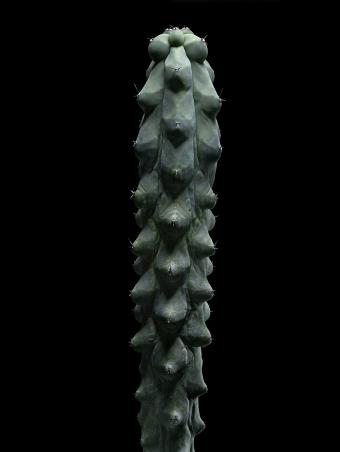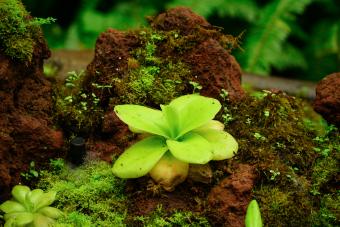
Weird plants are wild to look at, and they add a bit of wonder to our lives. Some are stinky, others prey on small creatures, and several just have an array of exceptionally odd features. If these awe-inspiring aspects of nature intrigue you, we highlight some of the strangest plants on the planet and even some weird houseplants that you can add to your abode!
Boobie Cactus

Scientific Name: Myrtillocactus Geometrizans 'Fukurokuryuzinboku'
We had to get your attention somehow! This rare type of cactus features a recognizable shape, hence its silly name. While sold at a small stature, this weird plant will quickly grow up to 15 feet in height! You can buy them in the states, but they are native to Mexico.
Boobie cacti make for flashy houseplants. Make sure they get lots of sun and very little water. In fact, unless they start to wither, watering should be avoided. And when this happens, keep in mind that it only takes a tiny amount of water to perk it back up!
Corpse Flower

Scientific Name: Amorphophallus titanum
As the name suggests, the corpse flower comes with quite the unappealing smell, reminiscent of rotting flesh. These massive plants can reach up to eight feet in height and four feet in width, and they call Indonesia home.
Thankfully, for those passing by, the corpse flower only blooms for 24 to 36 hours every three to seven years. Why does this plant have such a putrid smell? It's designed to attract pollinators like dung beetles and flesh flies. This ensures that the stinky species lives on!
The corpse flower also has another astounding ability — it can heat up to the temperature of a freshly deceased person, reaching 98°F! This helps to attract those insects even more.
Cobra Lily

Scientific Name: Darlingtonia californica
Cobra lilies get their name from their signature serpant-like shape. And just like snakes, these plants are carnivorous! This type of pitcher plant can be found in California and Oregon, and they prey on small insects.
They grow in bogs, reaching up to two feet in height, and their hood is translucent allowing light to shine through. This, combined with their curved shape, makes it difficult for insects to escape.
Pitcher plants grow in all shapes and sizes. Would you believe that one of these weird plants is actually large enough to eat small lizards and rats whole? It was discovered in 2009 in the Philippines.
Asian Bleeding Heart

Scientific Name: Lamprocapnos spectabilis
Despite the negative sounding name, this flower is downright beautiful! Native to Japan, Northern China, Korea, and Siberia, these perennials can get up to two to three feet in width and height. There are also eight different species of this particular type of plant.
The most intriguing, but less beautiful of the bunch, is the Pacific Bleeding Heart, which is fire resistant. This is fitting, since this variety is found in Washington, Oregon, and California, where wildfires are common.
Bleeding hearts are a beautiful addition to a backyard, doing best in light shade and well drained soil. However, they will not survive in super hot climates.
Window-Leaf Monstera

Scientific Name: Monstera deliciosa
This weird-looking plant gives the impression that someone got clever with a pair of scissors, or that a hungry, hungry caterpillar had a hearty lunch! However, these holes are there for a reason — they allow water to more effectively drip through to the roots, ensure that harsh winds do not rip apart the plant, and provide ample sunlight to all areas of the perennial.
When grown indoors, these plants can get to around eight feet in height. But in nature, they can almost double this number! To find them in the wild, you will have to travel to tropical rainforests in countries throughout Central America.
These make for more weird houseplants! Growing tips include: indirect sunlight, high humidity, and limited watering. Keep the soil on the drier side if possible.
Black Bat Flower

Scientific Name: Tacca integrifolia
It doesn't take a rocket scientists to see why this plant has its distinctive name! The black bat flower is native to South Asia, and it can grow up to three feet tall. Best of all, it begins to flower in late summer and early fall, which means that the frightening faces for this flower are in full view for Halloween.
Doll's Eyes

Scientific Name: Acatea pachypoda
Speaking of Halloween, doll's eyes are another creepy and weird looking plant that can commonly be found in eastern North America. Also called baneberry, this plant is poisonous, so you should avoid it.
Sadly, unlike the black bat flower, doll's eyes pop up in late spring and early summer, so you won't spot them around All Hallows' Eve.
Devil's Tooth

Scientific Name: Hydnellum Peckii
Yet another spooking looking plant, Devil's Tooth is actually a type of mushroom. The red, blood-like appearance is simply a sap that the fungi produces, but it definitely provides a creepy vibe. This weird plant is typically found in the forests of the Pacific northwest.
Interestingly enough, this mushroom is not toxic. However, it apparently has a very bitter flavor, so you probably wouldn't want to sink your teeth into it!
Living Stone Plant

Scientific Name: Lithops
This adorably weird plant is probably the cutest on our list! Each succulent plant only sprouts two thick leaves, giving it the appearance of loveable little stones. They come in an array of colors and patterns, making them a fun addition to a garden space.
While they originate from South Africa, these weird houseplants are great for growing indoors, and they don't take up a lot of space. Measuring only one to three inches wide and half an inch to an inch tall, you can hold a few in the palm of your hand.
These little guys love full sun, and they don't need a lot of water. When the soil dries out in the spring and fall, light watering is recommended, but leave your living stones be during the rest of the year.
Butterwort

Scientific Name: Pinguicula gigantea
Yet another carnivorous plant, the butterwort has what appears to be buttery soft leaves that are actually covered in short, sticky hairs that can hold on to small insects. Then, they secrete a liquid that contains enzymes which dissolve these tiny creatures.
Butterwort loves humid, mountain areas, so you can most often find it in Central and South America, as well as in Mexico. However, you can also keep it as a houseplant. One caveat though — if food is not available, you will have to provide it with some!
Sundew Plant

Scientific Name: Drosera capillaris
If you look at this plant close up, it might give you a flashback to 2020 when we were bombarded with images of the coronavirus. Ironically, it turns out that this tiny, tentacle plant is also a bit of a predator!
Sundews are another type of carnivorous plant, and those dew-like drops that are positioned around their perimeter are actually a sticky nectar that is designed to trap their prey. Once caught, the tentacles wrap around the insect, and the enzymes in the nectar allow the plant to digest it. You'll find these weird plants in the United States, preferring more tropical climates.
While touching sundew leaves is not harmful to humans, it can hurt the plant, so try to keep hands away!
Sign up for our newsletter featuring all the latest stories and products we love.
Western Skunk Cabbage

Scientific Name: Lysichiton americanus
Don't be fooled by this weird plant's beautiful exterior! The Western skunk cabbage has a pretty yellow flower to lure you in, but you will quickly find that is accompanied by a sulfur-like smell. When you look closer at this plant, you will also notice a feature that is reminiscent to a skunk's tail at its base.
The skunk cabbage is a cousin of the corpse flower that lives in the northern and western United States. They typically bloom in early March but can arrive sooner, which means that the cold is not a concern for this stinky plant!
Jellyfish Air Plant

Scientific Name: Tillandsia
This is a very popular weird houseplant for a very specific reason. When turned upside down and placed in a sea urchin shell, you have the ability to hang these plants from the ceiling, creating the illusion of floating jellyfish!
Even better, they are very low maintenance. They love humid environments, so steamy bathrooms are best. You simply mist them with water a few times a week and make sure they get direct sunlight.
Butterfly Wing Plant

Scientific Name: Christia obcordata
For butterfly fans, this weird plant is the one for you! It is native to areas like Australia and Taiwan. As the name implies, the leaves look like a cascading flutter of butterflies!
This plant isn't just a pretty face, though. It is also useful. In countries like Japan and Indonesia, butterfly wing plants are used for medicinal purposes, specifically for treating urinary tract blockages.
If you want to try your hand at growing these plants, they need indirect sunlight, lots of water, and temperatures between 65°F-85°F. Keep in mind, these plants are toxic to pets and people, so keep animals and kids away!
Night-Blooming Cereus

Scientific Name: Selenicereus grandiflorus
Looking at the beautiful white flower, this plant would seem anything but weird. However, this unique type of cacti is special because, like the corpse flower, it only blooms once in a blue moon.
When can you see this gorgeous sight? Like a vampire, it only comes out at night, and it is a limited viewing. For one night only, the flower will open right after sunset and wilt just before the sun rises.
These can be an indoor plant, but make sure they avoid afternoon sun. Water them regularly and keep them out of cold temperatures as they are a tropical plant.
Weird Plants Can Add Whimsy to Your Home

The world is a wonderfully weird place, filled with amazing flora and fauna. These are just a few of the odd specimens that you can find throughout nature.
If you are an anthophile and want to add some flare to your furnishings and spark curiosity in those who visit your home, weird plants can be a fun choice! Just make sure that they are safe to handle (especially if you have kids and pets), and that they will thrive in an indoor environment.







